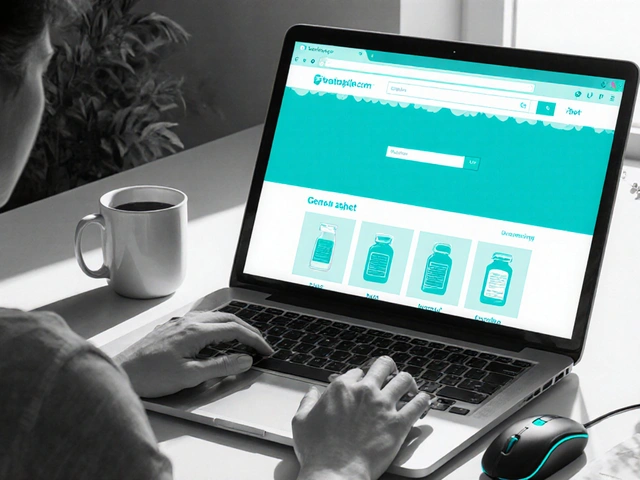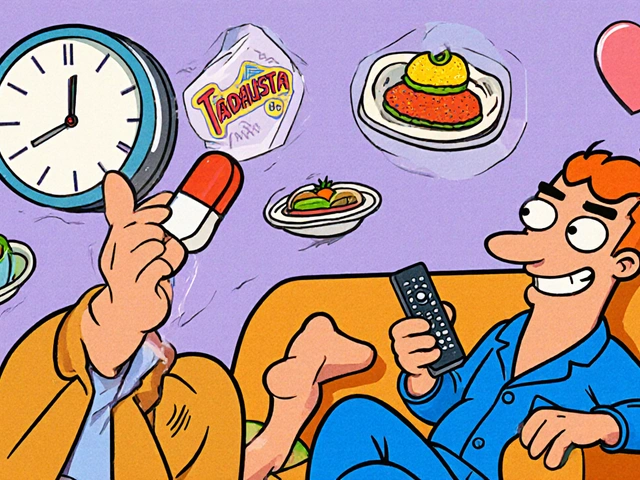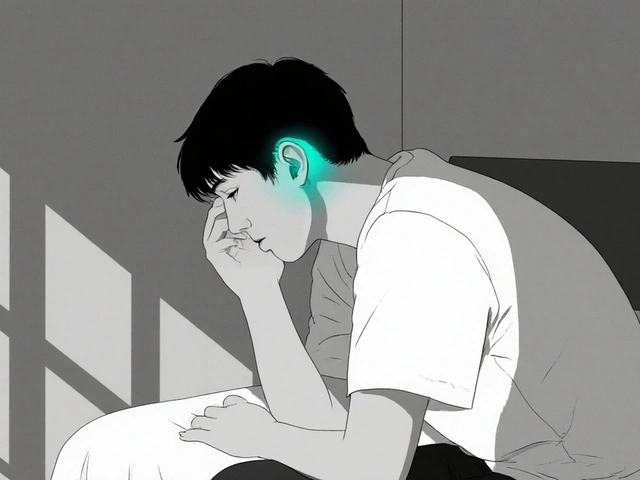What Is Polypharmacy-and Why Should You Care?
When someone takes five or more medications at the same time, that’s called polypharmacy. It’s not rare-it’s common. Nearly 4 in 10 older adults globally are on this many drugs. In the U.S., it’s even higher: over 65% of seniors visiting doctors are taking multiple prescriptions. And it’s not just pills from the pharmacy. Many also take over-the-counter painkillers, herbal supplements, or as-needed meds for sleep or anxiety. When you add them all up, the number climbs fast.
This isn’t about being on too many meds for fun. It’s usually because people have multiple chronic conditions-like high blood pressure, diabetes, arthritis, and heart disease. Each doctor treats their own piece of the puzzle. But no one’s looking at the whole picture. And that’s where things go wrong.
Why More Meds Don’t Mean Better Health
Every extra pill adds risk. It’s not linear-it’s exponential. With two drugs, there’s a 6% chance of a bad interaction. With five, that jumps to 50%. With seven or more, the risk is nearly 100%. Older bodies process drugs differently. Kidneys and liver don’t clear medications as quickly. That means drugs build up. Even small doses can become too strong.
Side effects get mistaken for new diseases. A dizziness from a blood pressure pill? That leads to a fall. A fall leads to a hip fracture. Then comes a new painkiller. Then a stomach protector. Then a sleep aid. This is called a prescribing cascade. One drug causes a problem. Another drug is added to fix it. And the cycle keeps going.
Studies show polypharmacy increases the risk of:
- Falls and fractures
- Hospital stays
- Cognitive decline and confusion
- Death
And it’s not just the drugs themselves. Managing ten different pills a day is overwhelming. Miss one? Take two by accident? Forget what each one is for? That’s normal for many seniors. And when that happens, safety goes out the window.
Who’s Most at Risk?
It’s not just age. It’s complexity. People over 70 are far more likely to be on multiple meds than those in their 60s. Those in nursing homes? Up to 80% are on five or more drugs. People with heart disease or diabetes? Their rates are even higher.
Women are more likely than men to be on polypharmacy-partly because they live longer, partly because they see doctors more often. And those with mental health conditions? One study found 80% of older adults hospitalized for psychiatric reasons were on five or more drugs, including multiple antidepressants, antipsychotics, and sedatives. That’s a dangerous mix.
And let’s not forget the financial toll. Paying for ten prescriptions a month adds up. Some seniors skip doses because they can’t afford them. Others take less than prescribed because they’re scared of side effects. Either way, it’s not working.

Deprescribing: Taking Meds Off, Not Just Adding More
Deprescribing isn’t about stopping everything. It’s about stopping what shouldn’t be there anymore. It’s asking: Is this drug still helping? Or is it just adding risk?
For example, a 78-year-old with mild arthritis might be on an NSAID for pain. But they also have high blood pressure and kidney issues. That NSAID could be doing more harm than good. A safer option? Physical therapy, heat packs, or a lower-risk pain reliever.
Another common case: benzodiazepines for sleep. These are sedatives like lorazepam or diazepam. They’re prescribed for short-term use-but many seniors stay on them for years. The risk? Falls, memory loss, confusion. The benefit? Maybe a few extra hours of sleep. Is it worth it?
Deprescribing follows a simple rule: Start with the drug that has the worst risk-to-benefit ratio. That’s often the one with the least evidence of long-term benefit and the highest chance of harm.
Tools Doctors Use to Decide What to Stop
There are two main guides doctors use to spot risky prescriptions:
- Beers Criteria: Developed by the American Geriatrics Society, this list names drugs that are generally unsafe for older adults. Examples include anticholinergics (like diphenhydramine in Benadryl), certain sleeping pills, and some NSAIDs.
- STOPP/START: STOPP finds inappropriate prescriptions. START finds ones that are missing. For example, if someone has heart failure but isn’t on a beta-blocker, that’s a START item.
These aren’t rules. They’re flags. A doctor might still prescribe a Beers drug if the benefits clearly outweigh the risks. But they shouldn’t do it without thinking twice.
Electronic health records now often flag these drugs automatically. But many doctors still don’t act on the alerts. Why? Time. Pressure. Fear.
Why Deprescribing Is So Hard
Even when the evidence says to stop, it’s hard to do.
Patients are scared. They think if a doctor gave them the pill, it must be necessary. They’ve been told for years, “Take this for your blood pressure,” “Take this for your sleep.” Stopping feels like giving up.
Doctors are scared too. What if the patient gets worse? What if they come back in a week with chest pain? What if the family blames them?
And there’s no financial incentive. Insurance pays for prescribing. It doesn’t pay for reviewing, questioning, or stopping. A 15-minute appointment doesn’t leave time for a full med review. Specialists don’t talk to each other. Primary care doctors are left holding the bag.
Pharmacists can help-but they’re often not part of the team. In Australia, pharmacist-led medication reviews are covered under Medicare. But in many places, they’re not. That’s a missed opportunity.

What Works: Real-World Success Stories
Deprescribing works when done right. One study in nursing homes found that when pharmacists reviewed all meds and worked with doctors to stop unnecessary ones, falls dropped by 22%. Emergency visits fell too.
In another program, older adults were invited to a medication review appointment. They brought all their pills-bottles, supplements, even the ones in the drawer. A pharmacist sat with them, one by one, asking: “Why are you taking this? What’s it for? Have you noticed any side effects?”
On average, they stopped 2.3 drugs per person. No one got worse. Many felt better. Less dizziness. Better sleep. More energy.
It’s not magic. It’s just asking the right questions.
What You Can Do Right Now
If you or someone you care for is on five or more medications:
- Make a full list. Write down every pill, patch, inhaler, supplement, and OTC med-even the ones you only take sometimes.
- Bring it to your next appointment. Don’t assume the doctor knows what’s in your cabinet. Bring the actual bottles.
- Ask these questions:
- What is this medicine for?
- Is it still needed?
- What happens if I stop it?
- Are there safer alternatives?
- Don’t stop anything on your own. Some drugs need to be tapered. Stopping cold turkey can be dangerous.
- Ask for a pharmacist review. Many pharmacies offer free med reviews. Use them.
The Future: Better Systems, Better Outcomes
Change is coming-but slowly. AI tools are being developed to scan health records and flag high-risk polypharmacy patterns. Some hospitals now have “medication reconciliation” teams that check all meds when someone is admitted or discharged.
Payment models are starting to shift. Instead of paying per prescription, some insurers are paying for outcomes: fewer falls, fewer ER visits, better quality of life. That changes the incentive.
But the biggest change? It’s not technology. It’s mindset. We need to stop thinking that more drugs = better care. We need to start thinking that less, when done right, can be safer and more effective.
For older adults, the goal isn’t to live longer with a dozen pills. It’s to live better-with fewer side effects, fewer falls, more clarity, and more freedom.
Is polypharmacy always dangerous?
No, not always. Some older adults need multiple medications to manage serious conditions like heart failure, diabetes, or kidney disease. The danger isn’t the number of drugs-it’s when the risks outweigh the benefits. A well-managed regimen with clear goals is safe. Polypharmacy becomes a problem when drugs are added without review, or when side effects aren’t monitored.
Can I stop my meds on my own if I feel better?
Never stop a prescription without talking to your doctor. Some medications, like blood pressure pills, antidepressants, or steroids, need to be tapered slowly. Stopping suddenly can cause rebound effects, withdrawal symptoms, or even life-threatening complications. Always ask before making changes.
What’s the difference between polypharmacy and inappropriate prescribing?
Polypharmacy just means five or more drugs. Inappropriate prescribing means taking a drug that’s risky for your age or condition-even if you’re only on one or two. For example, taking an anticholinergic like diphenhydramine (Benadryl) for sleep at age 75 is inappropriate, even if it’s your only medication. The Beers Criteria helps identify these cases.
Do herbal supplements count in polypharmacy?
Yes. Many seniors take ginkgo, fish oil, turmeric, or St. John’s wort, thinking they’re harmless. But these can interact with prescription drugs. Ginkgo can increase bleeding risk with blood thinners. St. John’s wort can make antidepressants or heart meds less effective. Always include supplements on your med list.
How often should older adults have a medication review?
At least once a year-and after any hospital stay, major illness, or change in health. If you’re on five or more drugs, consider a review every six months. The best time is during your annual wellness visit. Bring your full med list, and ask if anything can be safely reduced or stopped.
Are there any medications older adults should avoid completely?
Yes. The Beers Criteria lists several. Examples include: benzodiazepines (like diazepam) for sleep, anticholinergics (like oxybutynin for overactive bladder), and NSAIDs (like ibuprofen) for long-term pain in people with kidney or heart issues. These drugs have higher risks than benefits for most older adults. Safer alternatives usually exist.







Erika Puhan
November 8, 2025 AT 06:29Let’s be real - polypharmacy isn’t just a medical issue, it’s a systemic failure. The Beers Criteria has been around for decades, yet we’re still seeing 80% of nursing home residents on five-plus meds. Why? Because no one’s incentivized to do the hard work. Prescribing is easy. Deprescribing requires time, coordination, and accountability - none of which the system rewards. And don’t get me started on how primary care docs are drowning in EMR alerts they can’t possibly act on. It’s not negligence. It’s structural collapse.
Edward Weaver
November 9, 2025 AT 14:31Y’all act like this is some new crisis. In the US, we’ve been doing this for 20 years. Medicare Part D literally incentivizes prescribing. Pharma reps hand out free samples like candy. Doctors get paid per script, not per outcome. Meanwhile, in Canada or the UK, they review meds every 6 months. Here? You get a 7-minute visit and told to ‘take it as directed.’ We’re not broken - we’re designed this way. And no, ‘asking questions’ isn’t enough. We need policy change, not pep talks.
Lexi Brinkley
November 9, 2025 AT 23:49OMG YES 🙌 I’m so glad someone finally said this! My grandma was on 11 meds and now she’s down to 4 and she’s actually smiling again 😭💊➡️🌱 I told her doctor ‘if it’s not helping, why are we still giving it?’ and he was like ‘uh… good point.’ Like… why is this even a debate???
Kelsey Veg
November 11, 2025 AT 09:56so like… i read this whole thing and i think its kinda true but also… like… what if people just dont wanna be healthy? like my uncle takes 8 pills and he says ‘i dont care if they make me dizzy, at least im not dead’ and honestly? he’s kinda right. we’re so obsessed with ‘optimizing’ people that we forget they just wanna live. maybe the real problem is we think old people owe us better health.
Alex Harrison
November 12, 2025 AT 19:21I’ve seen this firsthand in my work as a home health aide. Seniors forget what each pill is for, mix up doses, or skip them because they’re too expensive. The system assumes they’re all organized and informed, but most are just trying to survive. A pharmacist review should be mandatory, not optional. And honestly, we need more community health workers who can sit down with people and walk them through their med list - not just a 10-minute check-in with a doctor who’s running late.
Jay Wallace
November 13, 2025 AT 15:25Let’s be clear: this isn’t ‘polypharmacy’ - it’s ‘pharmaceutical overreach.’ The Beers Criteria? A joke. It’s a laundry list of politically correct restrictions, not clinical wisdom. And STOPP/START? Both are outdated, poorly validated, and ignore individual variation. You want to reduce risk? Stop treating older adults like fragile porcelain dolls. Some of them need those ‘risky’ drugs. You’re not helping by removing them - you’re infantilizing them.
Alyssa Fisher
November 15, 2025 AT 05:29What’s interesting is how this mirrors our cultural fear of aging. We treat old age like a disease to be managed with more interventions, instead of accepting that bodies change - and sometimes, less is more. The real question isn’t ‘which drug to stop?’ - it’s ‘what kind of life are we trying to preserve?’ Is it a life filled with pills and fear of side effects? Or a life with fewer meds, more movement, more connection? The answer isn’t in the Beers Criteria. It’s in how we value presence over performance.
Alyssa Salazar
November 16, 2025 AT 00:55STOPP/START is great, but it’s useless if the prescriber doesn’t have the bandwidth to act on it. I’ve worked with geriatric teams where pharmacists flag 15 high-risk meds per patient - and the PCP says ‘I’ll get to it next quarter.’ Meanwhile, the patient is dizzy, constipated, and confused. We need embedded clinical pharmacists in primary care - not as consultants, but as co-managers. And insurance must pay for the time it takes to do this right. This isn’t ‘extra care’ - it’s basic safety.
Beth Banham
November 16, 2025 AT 20:15I just wanted to say thank you for writing this. My mom is 79 and on 6 meds. We started asking the questions you listed - and she’s down to 3 now. She sleeps better. She doesn’t stumble walking to the bathroom. It wasn’t about taking things away - it was about listening. I wish more doctors did that. Not all of them, but the ones who do? They’re heroes.
Brierly Davis
November 18, 2025 AT 07:26Biggest win? When you take away a drug that was never supposed to be there in the first place. I had a client on gabapentin for ‘nerve pain’ - no diagnosis, no history, just inherited from a prior doctor. We stopped it. No withdrawal. She said she felt ‘lighter.’ That’s the magic. Not adding. Removing. And it’s not magic - it’s just paying attention. You don’t need AI. You need a human who cares enough to ask: ‘Why are you taking this?’
Amber O'Sullivan
November 20, 2025 AT 01:05Herbal supplements are the wild west. People think turmeric is harmless but it’s a blood thinner. Ginkgo? Bleeding risk. St John’s wort? Kills antidepressants. No regulation. No labeling. No oversight. And doctors don’t ask because they assume it’s ‘natural’ so it’s safe. It’s not. It’s dangerous. And nobody’s talking about it enough
Jim Oliver
November 21, 2025 AT 08:34Of course deprescribing is hard. It requires thinking. And most doctors are too busy playing whack-a-mole with EMR pop-ups to actually think. Also, ‘patients are scared’? So are we. What if they die? Who’s liable? Who pays for the malpractice suit? This isn’t about ‘mindset’ - it’s about lawyers, insurance, and fear. Fix the system, not the patients.
William Priest
November 22, 2025 AT 09:55Let’s be honest - this whole ‘deprescribing’ thing is just another trend pushed by wellness influencers and overworked geriatricians who can’t handle real medicine. People need their meds. If you’re on 7 pills, you probably have 7 real problems. You don’t get to ‘optimize’ someone’s life by taking away their stability. This isn’t medicine - it’s ideology dressed in clinical jargon.
Ryan Masuga
November 22, 2025 AT 10:07My dad was on 9 meds. We did the full list, brought the bottles, asked the questions. He’s down to 4 now. He says he feels like himself again - not foggy, not dizzy, not tired all the time. No one’s saying stop everything. Just ask: ‘is this still helping?’ That’s it. No grand theory. Just care. And yeah, it takes time. But so does watching someone fade away because they’re too medicated to enjoy their grandkids. Worth it.